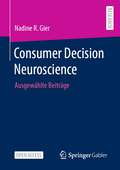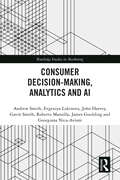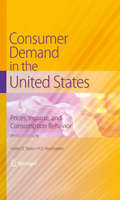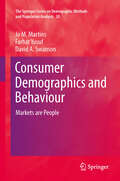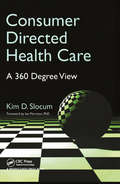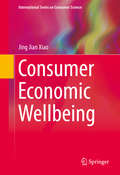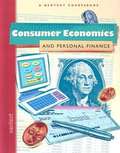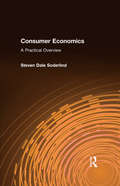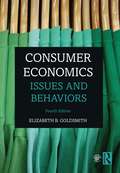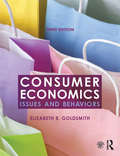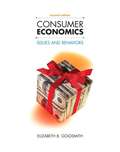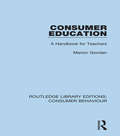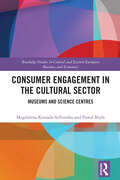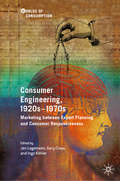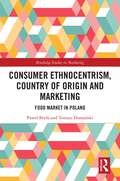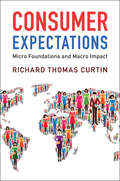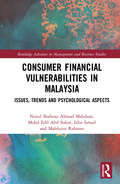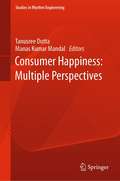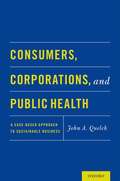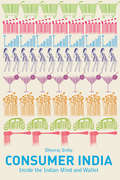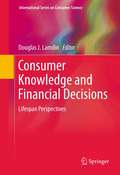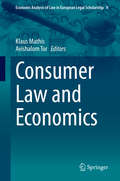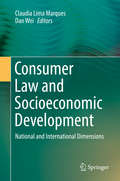- Table View
- List View
Consumer Decision Neuroscience: Ausgewählte Beiträge
by Nadine R. GierDieses Open-Access-Buch zur Consumer Decision Neuroscience verfolgt das Ziel, durch die Integration neurowissenschaftlicher Methoden in die Käufer- und Konsumentenverhaltensforschung die Identifikation verhaltensrelevanter, neurophysiologischer Variablen zu ermöglichen, um darauf aufbauend eine Theorieerweiterung zu schaffen. In ausgewählten Beiträgen werden Käufer- und Konsumentenentscheidungsprozesse anhand verschiedener methodischer, neurowissenschaftlich fundierter Herangehensweisen empirisch untersucht, um die Entscheidungsprozesse umfassend beschreiben, effektiver unterstützen und erfolgreich vorhersagen zu können.
Consumer Decision-Making, Analytics and AI (Routledge Studies in Marketing)
by John Harvey Andrew Smith Gavin Smith James Goulding Evgeniya Lukinova Roberto Mansilla Georgiana Nica-AvramMany decisions in our lives are decisions we make as consumers and buyers. Analytics- driven marketing underpinned by machine learning and AI has had a seismic impact on the execution of these decisions and on behavioural outcomes. This book dissects processes and issues at the heart of our emerging reality as human actors embedded in a system of exchange driven by fast-evolving technologies. It is a seminal work on a complex but urgent issue in social and behavioural science.Based on extant and emerging research, the book presents new evidence and innovative theoretical structures and concepts to explore how data analytics and AI can influence consumer thinking and behaviour. It synthesizes consumer research with the relevant literature on computational ‘thinking,’ human– computer interaction, AI, decision delegation and consumer analytics, linking them in a coherent fashion. The authors utilize original exhibits and real- world data in an accessible format to both engage and challenge the reader.This cutting- edge book is a must- read for scholars and upper- level students researching and studying marketing, consumer behaviour, AI, decision-making and behavioural science.
Consumer Demand in the United States: Prices, Income, and Consumption Behavior
by Lester D. Taylor H. S. HouthakkerA classic treatise that defined the field of applied demand analysis, Consumer Demand in the United States: Prices, Income, and Consumption Behavior is now fully updated and expanded for a new generation. Consumption expenditures by households in the United States account for about 70% of America's GDP. The primary focus in this book is on how households adjust these expenditures in response to changes in price and income. Econometric estimates of price and income elasticities are obtained for an exhaustive array of goods and services using data from surveys conducted by the Bureau of Labor Statistics and aggregate consumption expenditures from the National Income and Product Accounts, providing a better understanding of consumer demand. Practical models for forecasting future price and income elasticities are also demonstrated. Fully revised with over a dozen new chapters and appendices, the book revisits the original Houthakker-Taylor models while examining new material as well, such as the use of quantile regression and the stationarity of consumer preference. It also explores the emerging connection between neuroscience and consumer behavior, integrating the economic literature on demand theory with psychology literature. The most comprehensive treatment of the topic to date, this volume will be an essential resource for any researcher, student or professional economist working on consumer behavior or demand theory, as well as investors and policymakers concerned with the impact of economic fluctuations.
Consumer Demographics and Behaviour: Markets are People (The Springer Series on Demographic Methods and Population Analysis #30)
by David A. Swanson Farhat Yusuf Jo M. MartinsThis is the book that market strategists have been waiting for to position themselves in global markets and take advantage of the opportunities that demographic bonuses and deficits offer to them and their products. It is also a book for teachers and students of consumer behaviour to grasp the importance of the life cycle as a framework that shapes the demand for goods and services determined by changes in social, economic and physical functioning. It gives insights into gendered consumer behaviour and cohort effects. It presents a range of views on consumer behaviour and how demographic perspectives enhance these perspectives. The book offers conceptual and analytical tools that can be used in the assessment of population characteristics as determinants of market size, composition and potential for a variety of products. It offers organising frameworks as well as empirical evidence of consumer behaviour in clusters of markets, with different rates of population growth and age distribution that affect consumers' priorities and demand for basic and progressive commodities. The book shows commonalities as well as differences in consumer behaviour arising from different cultures and social customs. It uses analytical tools that are explained and accessible to readers with a range of competences. It is a book that can give a better understanding of consumer behaviour and market opportunities to the practitioner. It can also be used for the instruction of students in demography, consumer behaviour and marketing.
Consumer Directed Health Care: A 360 Degree View
by Kim SlocumWith three decades of experience in a variety of healthcare, pharmaceutical, and biotechnology firms, respected healthcare consultant, Kim Slocum applies a uniquely broad viewpoint to the U.S. healthcare crisis. He discusses how the system has evolved and debunks various myths that continue to persist. Exploring potential solutions, he balances many diverse and conflicting factors, including the movement to make healthcare more patient-centered and the growing trend to transfer significant portions of financial risk to patients via high-deductibles. Slocum closes the book by discussing what a successful consumer-directed system might look like and what steps would be required to make it happen.
Consumer Economic Wellbeing (International Series on Consumer Science)
by Jing Jian XiaoThis book focuses on the development of relevant theories and concepts that aid in predicting and modifying consumer behaviors. Consumer behaviors that help improve well-being, such as earning, spending, borrowing, and saving are also covered. In addition, the book discusses how to define consumer rights and responsibilities, and how individual consumers are organized to protect their own interests and to voice their concerns in public decision making processes. Finally, the book covers effects of economic environments on consumer well-being and how consumers can effectively deal with these challenges.
Consumer Economics and Personal Finance
by Robert Mayer John Burton Sharon Franklin Barbara Littman Mary Herd Tull Diane WildeThe first step in taking charge of your financial life is to figure out who you are.What are your talents and skills? What are you interested in? What are your values? What type of personality do you have? How do you learn best? Setting goals for yourself, both short-term and long-term goals, will help you decide what's important in life.You will be more likely to achieve your goals if they are: your own goals, realistic, stated in a positive way, reachable in a specific period of time, and shared with someone you trust.
Consumer Economics: A Practical Overview
by Steven Dale SoderlindThis work focuses on the service economy, it introduces the fundamentals of markets, consumer choice, financial assessment, risk avoidance, and other topics.
Consumer Economics: Issues and Behaviors
by Elizabeth B. GoldsmithFrom artificial intelligence to identity theft, from what we once thought of as unshakeable institutions to increasing concerns about privacy and sustainability, consumer issues are an integral part of daily life. This updated fourth edition of Consumer Economics offers students an accessible and thorough guide to the concerns surrounding the modern consumer and brings to light the repercussions of making uninformed decisions in today’s global economy. This definitive textbook introduces students to these potential issues and covers other key topics including consumer behavior, the history of the consumer movement, personal finance, legal rights and responsibilities, and marketing and advertising. Combining theory and practice, students are introduced to both the fundamentals of consumer economics and how to become better-informed consumers themselves. Highlights in this new edition include the following: New case studies and critical thinking projects to encourage students to develop their critical thinking skills through analyzing consumer issues. Expanded coverage of social media and the impact of social influence on consumers. Revised consumer alerts: practical advice and guidance to help students make smart consumer decisions. A companion website with PowerPoint slides for each chapter. Fully updated, this textbook is suitable for students studying consumer sciences—what works, what does not, and how consumers are changing.
Consumer Economics: Issues and Behaviors
by Elizabeth B. GoldsmithFrom identity theft to product recalls, from what we once thought of as unshakeable institutions to increasing concerns about sustainability, consumer issues are an integral part of modern life. This fully updated third edition of Consumer Economics offers students an accessible and thorough guide to the concerns surrounding the modern consumer and brings to light the repercussions of making uninformed decisions in today's economy. This definitive textbook introduces students to these potential issues and covers other key topics including consumer behavior, personal finance, legal rights and responsibilities, as well as marketing and advertising. Combining theory and practice, students are introduced to both the fundamentals of consumer economics and how to become better-informed consumers themselves. Highlights in this new edition include: New Critical Thinking Projects feature to encourage students to develop their critical thinking skills through analysing consumer issues. Expanded coverage of social media and the impact of social influence on consumers. Revised Consumer Alerts: practical advice and guidance for students to make smart consumer decisions. A new Companion Website with a range of presentation materials and exercises related to each chapter. Fully updated throughout, this textbook is suitable for students studying consumer sciences - what works, what doesn't, and how consumers are changing.
Consumer Economics: Issues and Behaviors (Second Edition)
by Elizabeth B. GoldsmithThis book provides an understanding of how the marketplace works, what our role is in it, and how our choices affect our lifestyles.
Consumer Education: A Handbook for Teachers (Routledge Library Editions: Consumer Behaviour)
by Marion GiordanEducation in consumer affairs has become increasingly important in recent years with the growth of consumer societies in many parts of the world. This practical handbook is a guide to teachers on the various aspects of the field; it looks at the consumer world in its political, social and economic context, describing how teachers have approached some of the subjects discussed in the book in class. Although based on the UK experience, it contains many references to global consumerism.
Consumer Engagement in the Cultural Sector: Museums and Science Centres (Routledge Studies in Central and Eastern European Business and Economics)
by Magdalena Kosiada-Sylburska Paweł BryłaThe essence of the book is to investigate the forms, benefits and limitations of engaging consumers in the development of cultural institution offerings. It aims to identify methods for culture product development with consumer engagement, in particular concerning exhibition and educational activities of cultural institutions. The volume provides an extensive literature review of issues related to market orientation, customer centricity, consumer engagement and co-creation of products and services, with an emphasis on the specificity of the cultural sector.The authors conduct research to capture different perspectives on consumer engagement, including those of consumers themselves, managers responsible for designing the offer and cultural institution employees. They identify forms, success factors of and barriers to involving consumers (visitors) in the development of museum offerings. The combination of quantitative and qualitative research methods provides novel and valuable insights into the phenomenon under study. This book will be of interest to scholars interested in culture marketing and consumer behaviour, as well as managers of museums, science centres and other cultural institutions.
Consumer Engineering, 1920s–1970s: Marketing between Expert Planning and Consumer Responsiveness (Worlds of Consumption)
by Gary Cross Jan Logemann Ingo KöhlerIn the middle of the twentieth century, a new class of marketing expert emerged beyond the familiar ad men of Madison Avenue. Working as commercial designers, consumer psychologists, sales managers, and market researchers, these professionals were self-defined “consumer engineers,” and their rise heralded a new era of marketing. To what extent did these efforts to engineer consumers shape consumption practices? And to what extent was the phenomenon itself a product of broader social and cultural forces? This collection considers consumer engineering in the context of the longer history of transatlantic marketing. Contributors offer case studies on the roles of individual consumer engineers on both sides of the Atlantic, the impact of such marketing practices on European economies during World War II and after, and the conflicted relationship between consumer activists and the ideas of consumer engineering. By connecting consumer engineering to a web of social processes in the twentieth century, this volume contributes to a reassessment of consumer history more broadly.
Consumer Ethnocentrism, Country of Origin and Marketing: Food Market in Poland (Routledge Studies in Marketing)
by Paweł Bryła Tomasz DomańskiCountry of origin and consumer ethnocentrism are evolving constructs as consumers’ perception of country, state, or region changes over time. Understanding consumer motivations and attitudes towards a country and its products can provide valuable insights for marketing strategies. This book explores the phenomena of consumer ethnocentrism and country-of-origin effect on the food market using examples from Polish retailers. The book aims to determine how appeals to the domestic or foreign country-of-origin provided through claims, symbols, labels, and quality signs can affect consumer attitudes and food purchase intentions as well as to contextualise consumer behaviour issues in the broader picture of the entire system of food production and distribution. The reader will gain a comprehensive understanding of consumer ethnocentrism and country-of-origin effect on the food market based on a series of original research studies conducted in Poland. The combination of quantitative and qualitative research methods provides novel and valuable insights into the phenomena under study. Based on original research, this innovative volume will be a valuable resource for consumer behaviour, food marketing, and international marketing scholars and students.
Consumer Expectations: Micro Foundations and Macro Impact
by Richard Thomas CurtinRichard Curtin has directed the University of Michigan's consumer sentiment surveys for more than four decades. His analyses of recent trends in consumer expectations are regularly covered in the worldwide press. In this book, Curtin presents a new theory of expectations. Whereas conventional theories presume that consumers play a passive role in the macro economy, simply reacting to current trends in incomes, prices, and interest rates, Curtin proposes a new empirically consistent theory. He argues that expectations are formed by an automatic process that utilizes conscious and nonconscious processes, passion and reason, information from public and private sources, and social networks. Consumers ultimately reach a decision that serves both the micro decision needs of individuals and reflects the common influence of the macro environment. Drawing on empirical observations, Curtin not only demonstrates the importance of consumer sentiment, but also how it can foreshadow the cyclical turning points in the economy.
Consumer Financial Dispute Resolution in a Comparative Context
by Shahla F. AliNearly all major global financial centres have developed systems of consumer financial dispute resolution. Such systems aim to assist parties to resolve a growing number of monetary disputes with financial institutions. How governments and self-regulatory organizations design and administer financial dispute resolution mechanisms in the context of increasingly turbulent financial markets is a new area for research and practice. Consumer Financial Dispute Resolution in a Comparative Context presents comparative research about the development and design of these mechanisms in East Asia, North America and Europe. Using a comparative methodology and drawing on empirical findings from a multi-jurisdictional survey, Shahla Ali examines the emergence of global principles that influence the design of financial dispute resolution models, considers the structural variations between the ombuds and arbitration systems and offers practical proposals for reform.
Consumer Financial Vulnerabilities in Malaysia: Issues, Trends and Psychological Aspects (Routledge Advances in Management and Business Studies)
by Nurul Shahnaz Ahmad Mahdzan Mohd Edil Abd Sukor Izlin Ismail Mahfuzur RahmanThis book examines four aspects of Malaysian consumers’ financial vulnerabilities. First, it discusses the issue of over-indebtedness due to excessive reliance on consumer financing. Second, the book investigates why Malaysians are ill-prepared for their golden years in terms of retirement planning and savings. Third, it delves into the problem of financial fraud victimisation among Malaysian consumers. Fourth, the book analyses the reasons why Malaysians are underinsured despite the distinct benefits of life insurance. Drawing on secondary data from government agencies such as Bank Negara Malaysia, Employees' Provident Fund, Royal Malaysian Police and the Department of Statistics Malaysia, each chapter presents statistical trends reflecting the four financial vulnerabilities. In-depth analyses of the literature reveal three broad psychological domains (cognition, motivation, and disposition) and specific psychological factors (e.g. over-confidence, self-control, social norms, and financial literacy) that significantly influence consumers’ financial decisions. The four financial vulnerabilities investigated in this book directly address the strategic outcomes of the Malaysian National Strategy for Financial Literacy 2019–2023 (MNSFL), a five-year plan to elevate the financial literacy of Malaysians. Finally, the book presents strategic recommendations that are believed to be useful guidelines for relevant policymakers to promote positive financial behaviours and rational attitudes among consumers. It will be a useful resource for policymakers and researchers interested in economic psychology and behavioural finance.
Consumer Happiness: Multiple Perspectives (Studies in Rhythm Engineering)
by Tanusree Dutta Manas Kumar MandalThis book helps quench the quest of knowledge of academicians, researchers, and others interested in developing a complete and critical understanding of consumer happiness. The relentless search of happiness by humans is sought in different ways. Scientific discussion on happiness for long was considered a forte of Philosophers. Other disciplines seldom delved into this. But today not only science but neuroscience, marketing, and other varied fields have started delving into it and have developed a keen interest. The book has been conceptualized on this line of thinking and thus divided into two parts. The first part is customized towards understanding various perspectives of happiness and the relative importance of knowing the same. The first chapter of this section is on the biological perspective of happiness. The second is titled ‘Behavioural perspective’. The third chapter is an attempt to elucidate the cultural perspective of the concept of happiness. The fourth is on the role of technology in inducing happiness. Fifth and sixth are on theories of happiness and measuring happiness, respectively. Knowledge about the different perspective and theories has a wide range of benefits. It informs us about how the brain works, interprets, and reacts. This theoretical understanding helps us to move beyond the trial and error methods towards a more scientific underpinning of adoption of measures that would generate long-lasting happiness in consumers.The second part of the book is dedicated toward understanding consumer happiness from a neuroscience perspective, i.e. keeping consumer happy. This segment has ten chapters. The first is on differentiating the concept of happiness from satisfaction. The second is on sensory marketing and happiness. The third deals with the store design and shelving of products to generate happiness. Fourth and fifth chapters relate to persuading the consumers. While the fourth chapter is on developing persuasive messages and the fifth is on subliminal messaging sixth chapter is on pricing and seventh on advertising. The eighth chapter highlights the role of emotions and the ninth is on the different factors that induce happiness in consumers. The last chapter is about raising some unanswered questions and food for thought for readers. Together the contents of the book make for a complete understanding of the concept of happiness and how it is shaping the world of marketing. Addressing the ‘what’ and ‘how’ of consumer happiness in the same book makes the book comprehensive.
Consumer Health
by John A. Quelch Emily C. BoudreauThe public health footprint associated with corporate behavior has come under increased scrutiny in the last decade, with an increased expectation that private profit not come at the expense of consumer welfare. Consumers, Corporations, and Public Health assembles 17 case studies at the intersection of business and public health to illustrate how each side can inform and benefit the other. Through contemporary examples from a variety of industries and geographies, this collection provides students with an appreciation for the importance of consumer empowerment and consumer behavior in shaping both health and corporate outcomes.
Consumer India
by Dheeraj SinhaA richly insightful account of one of the most significant transformations in the world today. Dheeraj Sinha's intelligence vividly illuminates the intersection of culture and commerce in New India. Adam Morgan Founder eatbigfish Among the many books I have read on the cultural evolution taking place in India, this is perhaps the most insightful. It does not just map mindset changes; it does so with the certainty of a person who has lived the changes as much as he has witnessed them. Every marketeer should keep this book on his office desk as a ready reckoner. Ranjan Kapur Country Manager - India WPP India in many ways is a "Nation of Nations. " So much heterogeneity and hence complexity in understanding consumers and consumerism. Dheeraj has done a commendable job in peeling off the layers from the onion-creating frameworks and providing very relatable examples to understand the culture. For instance, Dheeraj has used Bollywood as an effective mirror to portray societal changes. Consumer India is a must-read for those who want to understand the cultural evolution of India with its nuances. Rajesh Jejurikar Chief Executive - Automotive Division Mahindra & Mahindra Ltd. A labor of love. For years, I have marveled at how Dheeraj's inquisitive brain continuously churns away to make meaning of everything he observes. His writing simultaneously reflects him as a "sutradaar" telling the captivating story of a changing India, even as it does so with the unbiased and expert credentials of the "computerji" he describes here. Dheeraj insightfully marries the rapid changes he chronicles with the assimilative fabric of India; where "and" trumps "or. " Against the cliché "change is the only constant," he underlines that in India, change works with the constant. Enjoy the ride on Dheeraj's time machine! Prasad Narasimhan Managing Partner, Asia Brandgym
Consumer Knowledge and Financial Decisions: Lifespan Perspectives (International Series on Consumer Science)
by Douglas J. LamdinThere has been an increasing recognition that financial knowledge (i.e., literacy) is lacking across the population. Moreover, there is recognition that this lack of knowledge poses real problems as credit, mortgages, health insurance, retirement benefits, and savings and investment decisions become increasingly complex. Financial Decisions Across the Lifespan brings together the work of scholars from various disciplines (family and consumer sciences, economics, law, finance, sociology, and public policy) to provide a broad range of perspectives on financial knowledge, financial decisions, and policies. For consistency across the volume each chapter follows a similar format: (1) what individuals know or need to know (2) how what they know or need to know affects financial decisions and outcomes (3) ways in which policies or programs or financial innovations can enhance their knowledge, or decisions, or outcomes. Contributors will provide both new and existing research to create a valuable picture of the state of financial literacy and how it can be improved.
Consumer Law and Economics (Economic Analysis of Law in European Legal Scholarship #9)
by Klaus Mathis Avishalom TorThis edited volume covers the challenges currently faced by consumer law in Europe and the United States, ranging from fundamental theoretical questions, such as what goals consumer law should pursue, to practical questions raised by disclosure requirements, the General Data Protection Regulation and technology advancements. With governments around the world enacting powerful new regulations concerning consumers, consumer law has become an important topic in the economic analysis of law. Intended to protect consumers, these regulations typically seek to do so by giving them tools to make better decisions, or by limiting the consequences of their bad decisions. Legal scholars are divided, however, regarding the efficacy and effects of these regulations; some call for certain policies to be abolished, while others support a regulatory expansion.
Consumer Law and Protection: Protecting the Rights of Consumers
by Neal BevansIn recent years, the interest in consumer-related issues has grown tremendously, fueled by growing unemployment, high foreclosure rates, credit card interest rate increases and a recession more sweeping than anything seen in more than a generation. Unfortunately, when readers look for a text to explain these issues, they are too often confronted with case books that have more application to law school curricula than to a college-level course. This book fills the need for a well-written text on consumer law and consumer protection. <p><p>Covering topics as diverse as protecting a person's credit rating to avoiding predatory lending, Consumer Law & Protection explains the law and gives readers the tools that they need to protect themselves from telemarketers, unscrupulous debt collectors and network marketing schemes, to name only a few of the topics covered in the book.
Consumer Law and Socioeconomic Development: National and International Dimensions
by Dan Wei Claudia Lima MarquesThis book reflects the research output of the Committee on the International Protection of Consumers of the International Law Association (ILA). The Committee was created in 2008, with a mandate to study the role of public and private law to protect consumers, review UN Guidelines, and to model laws, international treaties and national legislations concerning protection and consumer redress. It has been accepted to act as an observer not only when the UNCTAD was updating its guidelines, but also at the Hague Conference on Private International Law. The book includes the contributions of various Committee members in the past few years and is a result of the cooperation between the Committee members and experts from Australia, Brazil, Canada and China. It is divided into three parts: the first part addresses trends and challenges in international protection of consumers, while the second part focuses on financial crises and consumer protection and the third part examines national and regional consumer law issues.
